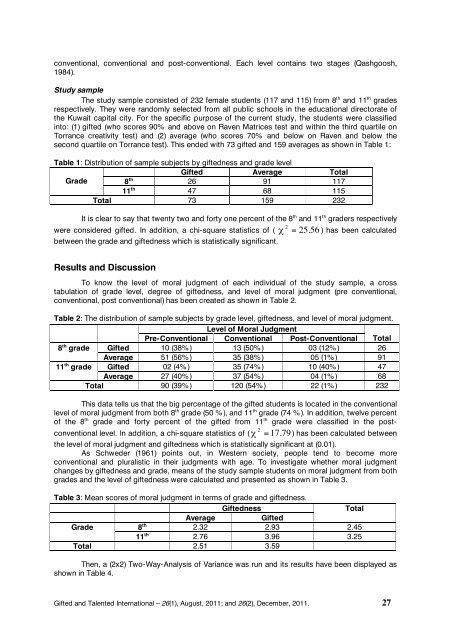The Journal of the World Council for Gifted and Talented Children
The Journal of the World Council for Gifted and Talented Children
The Journal of the World Council for Gifted and Talented Children
Create successful ePaper yourself
Turn your PDF publications into a flip-book with our unique Google optimized e-Paper software.
conventional, conventional <strong>and</strong> post-conventional. Each level contains two stages (Qashgoosh,<br />
1984).<br />
Study sample<br />
<strong>The</strong> study sample consisted <strong>of</strong> 232 female students (117 <strong>and</strong> 115) from 8 th <strong>and</strong> 11 th grades<br />
respectively. <strong>The</strong>y were r<strong>and</strong>omly selected from all public schools in <strong>the</strong> educational directorate <strong>of</strong><br />
<strong>the</strong> Kuwait capital city. For <strong>the</strong> specific purpose <strong>of</strong> <strong>the</strong> current study, <strong>the</strong> students were classified<br />
into: (1) gifted (who scores 90% <strong>and</strong> above on Raven Matrices test <strong>and</strong> within <strong>the</strong> third quartile on<br />
Torrance creativity test) <strong>and</strong> (2) average (who scores 70% <strong>and</strong> below on Raven <strong>and</strong> below <strong>the</strong><br />
second quartile on Torrance test). This ended with 73 gifted <strong>and</strong> 159 averages as shown in Table 1:<br />
Table 1: Distribution <strong>of</strong> sample subjects by giftedness <strong>and</strong> grade level<br />
<strong>Gifted</strong> Average Total<br />
Grade 8th 26 91 117<br />
11th 47 68 115<br />
Total 73 159 232<br />
It is clear to say that twenty two <strong>and</strong> <strong>for</strong>ty one percent <strong>of</strong> <strong>the</strong> 8th <strong>and</strong> 11th graders respectively<br />
2<br />
were considered gifted. In addition, a chi-square statistics <strong>of</strong> ( χ = 25.<br />
56 ) has been calculated<br />
between <strong>the</strong> grade <strong>and</strong> giftedness which is statistically significant.<br />
Results <strong>and</strong> Discussion<br />
To know <strong>the</strong> level <strong>of</strong> moral judgment <strong>of</strong> each individual <strong>of</strong> <strong>the</strong> study sample, a cross<br />
tabulation <strong>of</strong> grade level, degree <strong>of</strong> giftedness, <strong>and</strong> level <strong>of</strong> moral judgment (pre conventional,<br />
conventional, post conventional) has been created as shown in Table 2.<br />
Table 2: <strong>The</strong> distribution <strong>of</strong> sample subjects by grade level, giftedness, <strong>and</strong> level <strong>of</strong> moral judgment.<br />
Level <strong>of</strong> Moral Judgment<br />
Pre-Conventional Conventional Post-Conventional Total<br />
8th grade <strong>Gifted</strong> 10 (38%) 13 (50%) 03 (12%) 26<br />
Average 51 (56%) 35 (38%) 05 (1%) 91<br />
11th grade <strong>Gifted</strong> 02 (4%) 35 (74%) 10 (40%) 47<br />
Average 27 (40%) 37 (54%) 04 (1%) 68<br />
Total 90 (39%) 120 (54%) 22 (1%) 232<br />
This data tells us that <strong>the</strong> big percentage <strong>of</strong> <strong>the</strong> gifted students is located in <strong>the</strong> conventional<br />
level <strong>of</strong> moral judgment from both 8th grade (50 %), <strong>and</strong> 11th grade (74 %). In addition, twelve percent<br />
<strong>of</strong> <strong>the</strong> 8th grade <strong>and</strong> <strong>for</strong>ty percent <strong>of</strong> <strong>the</strong> gifted from 11th grade were classified in <strong>the</strong> post-<br />
2<br />
conventional level. In addition, a chi-square statistics <strong>of</strong> ( χ = 17.<br />
79 ) has been calculated between<br />
<strong>the</strong> level <strong>of</strong> moral judgment <strong>and</strong> giftedness which is statistically significant at (0.01).<br />
As Schweder (1961) points out, in Western society, people tend to become more<br />
conventional <strong>and</strong> pluralistic in <strong>the</strong>ir judgments with age. To investigate whe<strong>the</strong>r moral judgment<br />
changes by giftedness <strong>and</strong> grade, means <strong>of</strong> <strong>the</strong> study sample students on moral judgment from both<br />
grades <strong>and</strong> <strong>the</strong> level <strong>of</strong> giftedness were calculated <strong>and</strong> presented as shown in Table 3.<br />
Table 3: Mean scores <strong>of</strong> moral judgment in terms <strong>of</strong> grade <strong>and</strong> giftedness.<br />
<strong>Gifted</strong>ness Total<br />
Average <strong>Gifted</strong><br />
Grade 8 th 2.32 2.93 2.45<br />
11 th 2.76 3.96 3.25<br />
Total 2.51 3.59<br />
<strong>The</strong>n, a (2x2) Two-Way-Analysis <strong>of</strong> Variance was run <strong>and</strong> its results have been displayed as<br />
shown in Table 4.<br />
<strong>Gifted</strong> <strong>and</strong> <strong>Talented</strong> International – 26(1), August, 2011; <strong>and</strong> 26(2), December, 2011. 27


